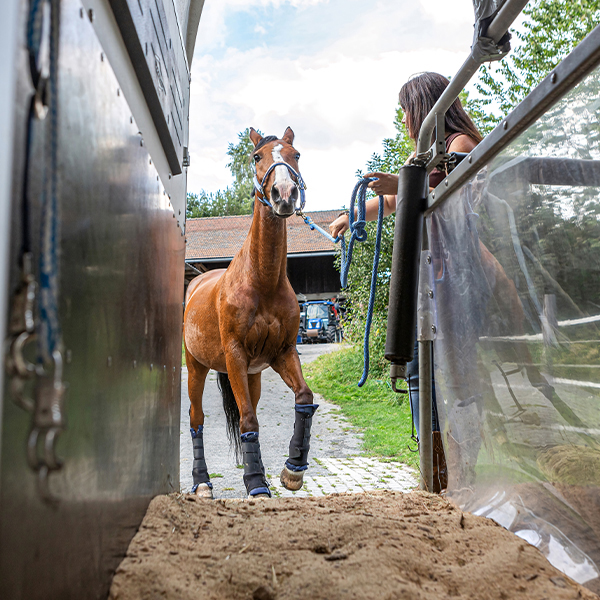With the warmer weather and longer days, show season across the United States is in full throttle. From local schooling shows, IHSA/IEA, Grand Prix or even the 2024 Paris Olympics, humans and horses are preparing for long bouts of travel which can bring a mixture of emotions.
From nervousness to exhaustion to excitement, showing can bring stress to both humans and horses. Horses react to stress similar to humans, but one system is particularly sensitive to stimulation from the transport and exercise: the digestive tract, particularly the hindgut microflora. Stress-induced alterations to this microflora could be detrimental to the horse’s well-being but if appropriate steps are taken, owners can avoid possible complications.
Facts About Hindgut Microflora
The horse’s hindgut is home to a variety of microflora that consists of bacteria, fungi and protozoa. This microflora is broken down into phylums with the most abundant being Firmicutes, Verrucomicrobia, Bacteroidetes and Spirochaetes, each with a specific function of helping the horse digest feedstuff. Collectively, these microflora phylums are vital to fermentation, an anaerobic (no oxygen) process where microflora breakdown carbohydrates. As the microflora breakdown carbohydrates, volatile fatty acids are produced, which are used for energy to help the horse perform daily functions.
How Transport and Exercise Stress Can Affect Microflora
Horses are unique livestock species as they are one of the few to not only be transported but also subjected to regular exercise. The equine hindgut can impact a horse’s physiology because of its complex microbial diversity and the horse’s stress sensitivity. Plenty of equine industry professionals would agree that transportation and exercise stress are major stress factors which could disturb the overall health of the horse, potentially causing behavioral, gastrointestinal, and other physiological issues.
Multiple studies have been conducted over the last few years evaluating how transport and exercise stress affects the delicate nature of gut microflora. Collectively, studies have found certain phylums, particularly Bacteroidetes and Firmicutes, are affected by certain durations of transport time, while others phylums are affected by exercise. In a study done in 2018, it was found that horses subjected to at least 3 hours of transport had significant differences in phylums Bacteroidetes and Firmicutes 48 hours after transport where Bacteroidetes levels increased while Firmicutes levels decreased. Bacteroidetes are an important microflora phylum since it is believed this phylum works with enzymes that target dietary polymers such as cellulose and pectin, two main components in most forages. A significant decrease in Firmicutes could have a negative effect as Firmicutes are believed to be active in carbohydrate and amino acid transport and metabolism. This decrease in Firmicutes levels after transportation stress has the potential to cause gastrointestinal issues due to effects on carbohydrate transport and metabolism.
In a 2016 study done with unfit but healthy Standardbred racehorses, it was found that after 12 weeks of intense exercise, there were significant changes in Bacteroidetes, Spirochaetes and Proteobacteria phyla, especially at the beginning of training. The cause of this could be the sudden change in lifestyle, from sedentary to highly active, which in turn affected which phyla needed to change to adjust to potentially increased nutritional needs.
Conclusions and Tips to Reduce Transport and Exercise Stress
Of course, all horses might not react the same way to all transport and exercise stress internally. There is a potential that horses who have been acclimated to frequent transport and exercise stress might not have significant gut microflora changes, but studies have yet to be conducted with acclimated horses.
If you notice your horse had adverse reactions to transport and exercise, consult with your veterinarian and your horse’s trainer about methods to reduce its stress levels. Your trainer and veterinarian might recommend that before you and your horse(s) start traveling and increasing exercise for show season to acclimate your horses to those factors first with a designated training plan.
For any further questions about transport and exercise stress contact your county’s Extension office. UT-TSU Shelby County Extension can be reached at 901-752-1207 during normal business hours Monday through Friday 8am-4:30pm CST.
To read more about the mentioned studies, please research the following citations:
Janabi, A.H.D., A.S. Biddle, D. Klein, and K.H. McKeever. “Exercise training-induced changes in the gut microbiota of Standardbred racehorses”. Comparative Exercise Physiology 12.3 (2016): 119-130. https://doi.org/10.3920/CEP160015 Web.
Szemplinski, KL, Thompson A, Cherry N, Guay K, Smith WB, Brady J, Jones T (2020).
Transporting and Exercising unconditioned horses: Effects on microflora populations. J Equine Vet Sci 90: 102988. https://doi.org/10.1016/j.jevs.2020.102988.










